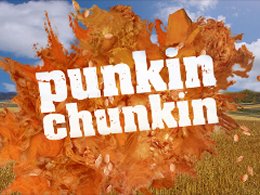If you live on or near the Eastern Shore, you likely turn giddy just thinking about the weekend after Halloween. Why? Because of the yearly pumpkin-launching event known as Punkin Chunkin. During this weekend-long tradition, dozens of pumpkin-hurling teams compete to see who has created the ultimate pumpkin throwing machine.
There are several different classes for chunkers to enter. Machine classes include centrifugal, catapult, trebuchet, air cannon, and human powered torsion. There are adult, female, and youth categories. Last year, it’s estimated that roughly 20,000 people showed up to see the machinists launch pumpkins out of the wacky devises mentioned. Seeing a medium-sized pumpkin explode out of a medieval looking machine is quite a site. Since 1986, after a bet about who could throw a pumpkin the furthest, spectators have traveled to Bridgeville, DE to witness pumpkins fly through the autumn skies.
Each machine has three attempts to fire during one measured competition each day. After each machine has fired competitively, the range is opened for ‘free fires’. This is the best time to watch the crews have fun with their pumpkin throwing gadgets.
“You only have three throws in the whole competition. You have to make every throw count,” said Steve Seigars, member of the Yankee Seige Team.
There are many factors when it comes to flinging a pumpkin that far.
“Don’t throw an orange pumpkin. Almost all chunkers throw Lumina pumpkins. The white, smooth-skinned, relatively spherical, thick walled, dense pumpkins,” said Seigars in regards to pumpkin selection.
“Only throw your densest pumpkins. Dense pumpkins fly further,” continued Seigars.
Pumpkins are 90 – 95% water. It makes sense that the densest, heaviest pumpkins would travel the furthest. Just imagine a heavy, dense canon ball soaring through the sky. Now, compare that to a white pumpkin. Hopefully, some pumpkins turn into ‘pie in the sky’ after being launched. That’s what the chunkers call it when a pumpkin explodes from the forces exuded after takeoff. Watery orange pumpkin parts soak the ground, some of the crowd, and whatever lies in their path.
Pumpkin Chunkin takes place on November 4 – 6, 2011. The event, which has caught world-wide attention in recent years, will be broadcast on Thanksgiving Day if you aren’t able to attend this year. Watch the special Thanksgiving simulcast on the Discovery Channel or Science Channel on Thursday, November 24th at 8 pm. If you are at the event this week, keep your eyes peeled for Kari Byron, Grant Imahara, and Troy Belleci, the 2011 Punkin Chunkin hosts and the team from Discovery’s Mythbusters program. The trio will be walking around, conducting interviews, and discussing the event’s liveliness all weekend long.
Adult tickets cost $10 per person per day. Children 10 and under are free. Parking is included in each ticket fee, unless you are hauling an oversized vehicle or have a trailer. Wear warm shoes, preferably waterproof boots, because the ‘parking lot’ is actually just a large, rough, plowed cornfield in the middle of nowhere. Gates open at 7:30 am each day and competitions begin at 8 am. Events like concerts, contests, pageants, and chunkin continue until about 7 pm during the weekend.
Not only does Punkin Chunkin provide entertainment, but the event also supports innovative engineering and practical science. The World Punkin Chunkin Association (WCPCA) is a trademark nonprofit organization that raises money for scholarships. Part of the admission cost benefits youth and local communities around the Eastern Shore and Delaware. WCPCA believes in cultivating odd, challenging, and competitive science-based ideas. It’s obvious that all chunkin teams entered are creative, passionate, and have mastered engineering feats.
If interested in attending the 2011 Punkin Chunkin event and supporting the WCPCA, plug these coordinates into your GPS: 38.24358 latitude, -75.590229 longitude. If driving, using the GPS points will be your best bet, otherwise, take Route 13 to Bridgeville, DE, then to Route 404. Remember, Punkin Chunkin is held in an immense cornfield. Be on the lookout for signs, or traffic, that will direct you to where you need to park.









